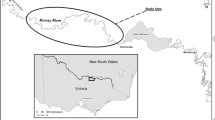Abstract
The effects of short-term fluctuations in river discharge simulating a hydroelectricity peaking regime on the hydrogeological environment of the brook trout's reproductive habitats were examined. Fluctuating river levels altered shallow (≤ 2.5 m) groundwater pathways, chemistry, and flow potentials within the river bed at spawning and incubation sites. Rising river levels introduced river water into the bank where various degrees of mixing with groundwater occurred. Subsequent recessions of river levels increased the potentials for groundwater flow, particular in an offshore direction. The character of the river water — groundwater interaction appeared to be related to the hydrogeological nature of the river channel and adjacent catchment which varied among sites. The observations suggested hydroelectricity peaking regimes have potential negative impacts on brook trout reproduction.
Similar content being viewed by others
References
Bain, M. B., J. T. Finn & H. E. Booke, 1988. Streamflow regulation and fish community structure. Ecology 69: 382–392.
Becker, C. D., D. A. Neitzel & C. S. Abernethy, 1983. Effects of dewatering on chinook salmon redds: Tolerance of four developmental phases to one-time dewatering. N. Am. J. Fish. Mgmt. 3: 373–382.
Brick, C., 1986. A model of groundwater response to reservoir management and the implications for kokanee salmon spawning, Flathead Lake, Montana. M. Sc. Thesis, University of Montana.
Burt, D. W. & J. H. Mundie, 1986. Case histories of regulated stream flow and its effects on salmonid populations. Can. Tech. Rep. Fish. aquat. Sci. 1477: 98 pp.
Curry, R. A., P. M. Powles, V. A. Liimatainen & J. M. Gunn, 1991. Emergence chronology of brook charr, Salvelinus fontinalis, alevins in an acidic stream. Envir. Biol. Fish. 31: 25–31.
Elliott, J. M., 1989. Mechanisms responsible for population regulation in young migratory trout, Salmo trutta. I. The critical time for survival. J. anim. Ecol. 58: 987–1001.
Fraser, J. M., 1982. An atypical brook charr (Salvelinus fontinalis) spawning area. Envir. Biol. Fish. 7: 385–388.
Fraser, J. M., 1985. Shoal spawning of brook trout, Salvelinus fontinalis, in a Precambrian Shield lake. Nat. can. 112: 163–174.
Freeze, R. A. & J. A. Cherry, 1979. Groundwater, New Jersey: Prentice-Hall Inc.
Gilbert, N., 1989. Biometrical Interpretation. Making Sense of Statistics in Biology. Second Edition, New York: Oxford University Press.
Godbout, L. & H. B. N. Hynes, 1982. The three dimensional distribution of the fauna in a single riffle in a stream in Ontario. Hydrobiologia 97: 87–96.
Gunn, J. M., 1986. Behaviour and ecology of salmonid fishes exposed to episodic pH depressions. Envir. Biol. Fish. 17: 241–252.
Hoar, W. S. & D. J. Randall (eds), 1969. Fish Physiology. Vol. 1, New York: Academic Press Inc.
Hvorslev, M. J., 1951. Time lag and soil permeability in groundwater observations. U.S. Army Corps Engrs. Waterways Exp. Sta. Bull. 36. Vicksburg, VA.
Lee, D. R. & J. A. Cherry, 1978. A field exercise on groundwater flow using seepage meters and mini-piezometers. J. Geol. Ed. 27: 6–10.
Ontario Ministry of the Environment, 1988. Acid Precipitation in Ontario Study — Annual Statistics of Concentration and Deposition — Cumulative Precipitation Monitoring Network, 1983–1988.
Pfannkuch, H. D. & T. C. Winter, 1984. Effect of anisotropy and groundwater system geometry on seepage through lakebeds. J. Hydrol. 75: 213–237.
Power, G., 1980. The brook charr, in E. K. Balon (ed.), Charrs, Salmonid Fishes of the Genus Salvelinus: Dr W. Junk Publishers, The Hague: 141–203.
Reiser, D. W. & T. A. Wesche, 1977. Determination of physical and hydraulic preferences of brown and brook trout in the selection of spawning locations, U.S. Dept. Interior, Water Resources Series No. 64.
Reiser, D. W. & R. G. White, 1983. Effects of complete redd dewatering on salmonid egg-hatching success and development of juveniles. Trans. am. Fish. Soc. 112: 532–540.
SAS Institute Inc., 1985. SAS/STAT User's Guide, Version 6, Fourth Edition. Cary, NC.
Scott, W. B. & E. J. Crossman, 1979. Freshwater Fishes of Canada. Bulletin 184, Fisheries Research Board of Canada: Ottawa.
Silver, S. J., C. E. Warren & P. Doudoroff, 1963. Dissolved oxygen requirements of developing steelhead trout and chinook salmon embryos at different water velocities. Trans. am. Fish. Soc. 92: 327–343.
Smith, A. K., 1973. Development and application of spawning velocity and depth criteria for Oregon salmonids. Trans. am. Fish. Soc. 102: 312–316.
Snucins, E. J., R. A. Curry & J. M. Gunn, 1992. Embryo habitat and timing of alevin emergence of a lake-dwelling brook trout (Salvelinus fontinalis) population. Can. J. Zool. 70: 423–427.
Sowden, T. K. & G. Power, 1985. Prediction of rainbow trout embryo survival in relation to groundwater seepage and particle size of spawning substrate. Trans. am. Fish. Soc. 114: 804–812.
Triska, F. J., V. C. Kennedy, R. J. Avanzino, G. W. Zellweger & K. E. Bencala, 1989. Retention and transport of nutrients in a third-order stream in northwestern California: hyporheic process. Ecology 70: 1873–1905.
Vaux, W. G., 1968. Intragravel flow and interchange of water in a streambed. U.S. Fish Wildl. Serv., Fish. Bull. 66: 479–489.
Vervier, P., J. Gilbert, P. Marmonier & M.-J. Dole-Olivier, 1992. A perspective on the permeability of the surface freshwatergroundwater ecotone. J. N. Am. Benthol. Soc. 11: 93–102.
White, D. S., 1990. Biological relationships to convective flow patterns within stream beds. Hydrobiology 196: 149–158.
Winter, T. C., 1974. Numerical simulation analysis of the interaction of lakes and groundwater. U.S.G.S., Geol. Surv. Prof. Paper 1001.
Young, M. K., W. A. Hubert & T. A. Wesche, 1989. Substrate alteration by spawning brook trout in a southeastern Wyoming stream. Trans. am. Fish, Soc. 118: 379–385.
Author information
Authors and Affiliations
Rights and permissions
About this article
Cite this article
Curry, R.A., Gehrels, J., Noakes, D.L.G. et al. Effects of river flow fluctuations on groundwater discharge through brook trout, Salvelinus fontinalis, spawning and incubation habitats. Hydrobiologia 277, 121–134 (1994). https://doi.org/10.1007/BF00016759
Received:
Revised:
Accepted:
Issue Date:
DOI: https://doi.org/10.1007/BF00016759




